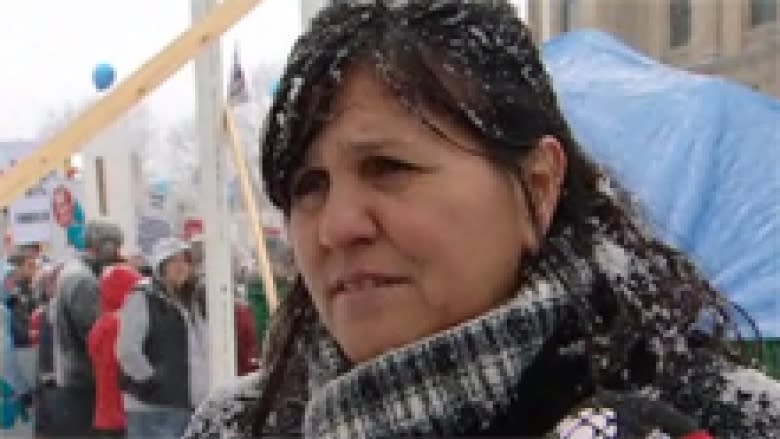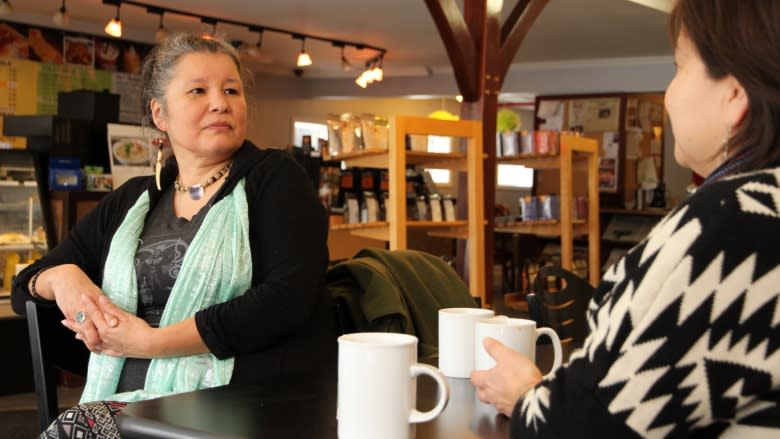N.B. considers St. Mary's land deal if Sisson mine approved
Energy and Mines Minister Donald Arseneault told CBC News the provincial government would consider giving St. Mary's First Nation a piece of land if the $579-million Sisson mine project is approved.
"I don't think anything is out of the question, how we can make that happen, if that is such a high priority of St. Mary's," Arseneault said.
The open-pit tungsten and molybdenum mine would be built on 12.5 square kilometres of Crown land near Napadogan, north of Fredericton, which St. Mary's says is Maliseet territory.
Although the First Nation is opposed to the project, St. Mary's raised the idea of receiving land in lieu of the Crown land that would be taken up by the project, in a letter to provincial and federal government officials.
"We assert Aboriginal title to the area where the mine is being proposed," St. Mary's Chief Candice Paul said in the letter, dated Dec. 11, 2014.
In New Brunswick, First Nations never surrendered their right to Crown land, unlike in some other areas of Canada.
"The mine would destroy this part of our territory, it would never be the same again," Paul said.
In St. Mary's letter to the government, Paul said the provincial government should consider buying a piece of private land for the First Nation if there's not a piece of Crown land available, so St. Mary's would be able to continue performing traditional activities, such as hunting and fishing.
"Those are discussions that are ongoing and we'll see how we can accommodate in the best way we can," Arseneault said.
But the St. Mary's chief says her letter has gone unanswered and the provincial government has not been meeting its duty to consult obligations to accommodate First Nations on the proposed Sisson mine.
"[The provincial government] needs to meet their obligation and come to the table," Paul said.
Arseneault told CBC News the provincial government has consulted with St. Mary's and other First Nations across the province.
"Look, I want to see this project go through and I'm sure Chief Candice Paul wants to see it come through," Arsenault said.
"Let's make sure it's a win-win for everybody."
Paul has publicly said several times she does not want to see the project move forward because of environmental and aboriginal title concerns.
A provincial and federal environmental review on the Sisson mine are currently under way, both expected to be released this year.
Arseneault has said the project is on it's way to becoming a reality.
The federal government has responded to St. Mary's letter and a meeting is set up for later this month, according to Paul.
Supreme Court case a game-changer in N.B.
St. Mary's would take the provincial government to court if the province doesn't engage in meaningful dialogue with the First Nation, according to Paul.
"They have a duty to accommodate, [if] they can't meet that, then it could be a deal-breaker," said Paul.
St. Mary's has hired a lawyer from the Victoria-based firm Woodward & Company, who was also one of the lawyers that represented the Tsilhqot'in First Nation in a landmark Supreme Court case last June.
The historic land ruling granted aboriginal title to the Tsilhqot'in on more than 1700 square kilometres of land in British Columbia. The decision puts a greater onus on governments to justify economic development on aboriginal land wherever there are outstanding land claims, such as New Brunswick.
"The decision of the Supreme Court of Canada this summer didn't change the law, but it confirmed that aboriginal title is a reality, it's not just a legal theory, it actually exists," said Dominique Nouvet, St. Mary's lawyer.
Taking the government to court would be a last resort, according to Nouvet. But she says the highest court's ruling would be a game-changer in New Brunswick.
"The project itself would be an unjustified infringement of Maliseet aboriginal title," Nouvet said.
"[The Supreme Court ruling] is a wake-up call to all the governments in Canada that the status quo can't continue. Government can't keep approving projects in aboriginal groups traditional territory without regard for the consequences," Nouvet said.
First Nations divided
Darrell Paul, the executive director of the Union of New Brunswick Indians, said he doesn't agree with St. Mary's land proposal.
"If the project goes ahead, I see nothing at all why St. Mary's or any other First Nation should go negotiate with the government for another piece of land elsewhere to compensate it," Paul said.
"The First Nation doesn't need permission. And if they do that, ask the government to be allotted access to other Crown land is admitting the government owns the land, which they don't, it's all our land, it's all under aboriginal title."
St. Mary's says the land is Maliseet territory, but that doesn't include the Mi'kmaq First Nations in New Brunswick.
"No one First Nation can claim aboriginal title only to a certain area," Darrell Paul said.
"I think all First Nations should be consulted [by the government], not just one or two or three," Paul added.
CBC News also asked for a response from the Assembly of First Nations' Chiefs in New Brunswick. The organization represents most First Nations in the province, not including St. Mary's and a few other First Nations.
"The assembly has no comment on St. Mary's accommodation proposals," the AFN Chiefs said.
Unlike St. Mary's, the assembly has not taken a stance against the Sisson mine.
"The consultation process has had problems and the assembly's chiefs are monitoring that process closely while keeping all of their options open," said a statement to CBC News from the AFN Chiefs.
The Sisson mine has divided First Nations, according to Beverly Perley, a member of Tobique First Nation, and a past archaeological monitor at the project site.
"We're used to fighting against government, we're not used to getting hollered at by our own people," Perley said.
"Money is what divides us. Most of the division is between the grassroots people, and the Indian Act Chief and councils of the bands, and even that in itself is divided."
St. Mary's proposes revenue sharing
St. Mary's has also proposed alternative ideas on how the provincial government can accommodate First Nations if the Sisson mine is approved.
Chief Candice Paul asked the provincial and federal government to consider revenue sharing with the First Nation on the mine, long-term training education and employment for aboriginal people, funding for additional research and measures to enhance the salmon population in the area, and the creation of a compensation fund for aboriginal people if the mine contaminates the territory or natural resources.
"Those discussions within the company and First Nations are going to be ongoing and what those accommodations may be," Arseneault said.
St. Mary's points out creating a compensation fund would ensure the First Nation is covered if a mining disaster happened.
"As the Mt. Polley dam failure in BC confirms, mining disasters are a real possibility no matter what mining company promises during the approval process," Paul said in her letter to the government.
The breach of the tailings pond dam at the copper and gold mine near in British Columbia last August released 25 million cubic metres of contaminated water and mining waste into creeks and rivers.
An independent investigation has determined the breach was caused by a failure to detect a weak layer in the dam's foundation.
Northcliff Resources says it's committed to working with government regulators to ensure the company builds a project that is safe and environmentally responsible
"We are also committed to meaningful consultation with First Nations and stakeholders as we strive to build a project that will generate significant benefits for the people of New Brunswick," said a statement to CBC News from Northcliff Resources.



